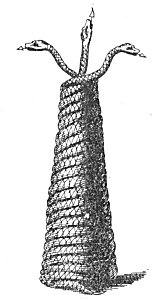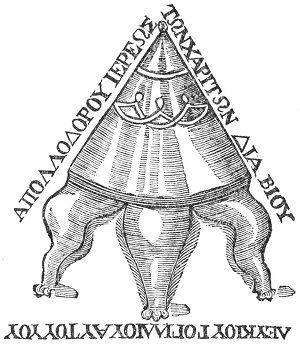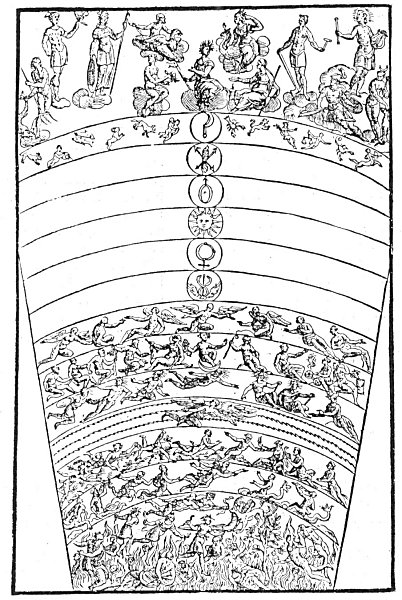Ever-burning lamps have been discovered in all parts of the world. Not only the Mediterranean countries but also India, Tibet, China, and South America have contributed records of lights which burned continuously without fuel. The examples which follow were selected at random from the imposing list of perpetual lamps found in different ages.
Plutarch wrote of a lamp that burned over the door of a temple to Jupiter Ammon; the priests declared that it had remained alight for centuries without fuel.
St. Augustine described a perpetual lamp, guarded in a temple in Egypt sacred to Venus, which neither wind nor water could extinguish. He believed it to be the work of the Devil.
An ever-burning lamp was found at Edessa, or Antioch, during the reign of the Emperor Justinian. It was in a niche over the city gate, elaborately enclosed to protect it from the elements. The date upon it proved that the lamp had been burning for more than 500 years. It was destroyed by soldiers.
During the early Middle Ages a lamp was found in England which had burned since the third century after Christ. The monument containing it was believed to be the tomb of the father of Constantine the Great.
The Lantern of Pallas was discovered near Rome in A.D. 1401. It was found in the sepulcher of Pallas, son of Evander, immortalized by Virgil in his Æneid. The lamp was placed at the head of the body and had burned with a steady glow for more than 2,000 years.
In A.D. 1550 on the island of Nesis, in the Bay of Naples, a magnificent marble vault was opened in which was found a lamp still alight which had been placed there before the beginning of the Christian Era.
Pausanias described a beautiful golden lamp in the temple of Minerva which burned steadily for a year without refueling or having the wick trimmed. The ceremony of filling the lamp took place annually, and time was measured by the ceremony.
According to the Fama Fraternitatis, the crypt of Christian Rosencreutz when opened 120 years after his death was found to be brilliantly illuminated by a perpetual lamp suspended from the ceiling.
Numa Pompilius, King of Rome and magician of considerable power, caused a perpetual light to burn in the dome of a temple he had created in honor of an elemental being.
In England a curious tomb was found containing
BASE OF A DELPHIAN TRIPOD.
From Montfaucon’s Antiquities. The windings of these serpents formed the base, and the three heads sustained the three feet of the tripod. It is impossible to secure satisfactory information concerning the shape and size of the celebrated Delphian tripod. Theories concerning it are based (in most part) upon small ornamental tripods discovered in various temples.
THE DELPHIAN TRIPOD RESTORED.
From Beaumont’s Gleanings of Antiquities. According to Beaumont, the above is the most authentic form of the Delphian tripod extant; but as the tripod must have changed considerably during the life of the oracle, hasty conclusions are unwise. In his description of the tripod, Beaumont divides it into four Parts: (1) a frame with three (2), a reverberating basin or bowl set in the frame; (e) a flat plate or table upon which the Pythia sat; and (4) a cone-shaped cover over the table, which completely concealed the priestess and from beneath which her voice sounded forth in weird and hollow tones, Attempts have been made to relate the Delphian tripod with the Jewish Ark of the Covenant. The frame of three legs was likened to the Ark of the Covenant; the flat plate or table to the Mercy Seat; and the cone-shaped covering to the tent of the Tabernacle itself. This entire conception differs widely from that popularly accepted, but discloses a valuable analogy between Jewish and Greek symbolism.
p. 62
an automaton which moved when certain stones in the floor of the vault were stepped upon by an intruder. At that time the Rosicrucian controversy was at its height, so it was decided that the tomb was that of a Rosicrucian initiate. A countryman, discovering the tomb and entering, found the interior brilliantly lighted by a lamp hanging from the ceiling. As he walked, his weight depressed some of the floor stones. At once a seated figure in heavy armor began to move. Mechanically it rose to its feet and struck the lamp with an iron baton, completely destroying it, and thus effectually preventing the discovery of the secret substance which maintained the flame. How long the lamp had burned is unknown, but certainly it had been for a considerable number of years.

Moe is the founder of GnosticWarrior.com. He is a father, husband, author, martial arts black belt, and an expert in Gnosticism, the occult, and esotericism.








